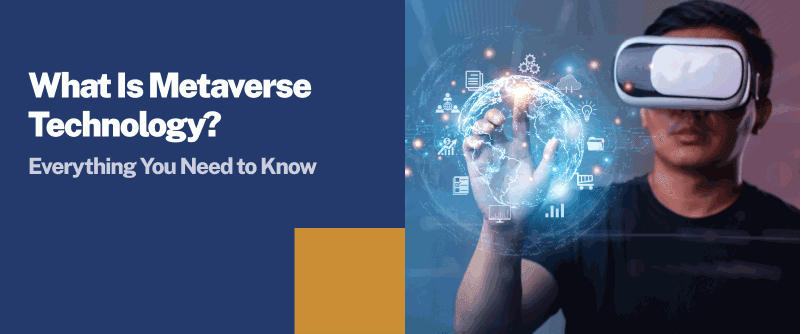5800 students unlocked their dream jobs with UG/PG programs in top colleges. Apply Now!
You've likely heard this term being thrown around recently, especially alongside other terms like crypto, NFTs, and blockchain, among others. It's all the rage right now, and according to many, it's the future or the next best step for things like art, music, entertainment - and even education.
While this sounds exciting, what is the metaverse? Or what is metaverse technology, and how does that fit into our daily lives? In simple terms, it's a place where the real world meets the virtual world. Some also call it the next iteration of the internet.
Now with such a tectonic transition in the tech world is exciting for students who want to be a part of it. If you are also one of them and want to enter the world of IT and tech, you may consider getting admission into an MCA program. For many years, an MCA degree has been one of the most popular courses for Indian students because it allows them to enter the computer application industry.
[Also Read: Top New Technology Trends]
What Is Metaverse: A Closer Look Into The Meaning Of The Metaverse
Neal Stephenson initially coined the term in his 1992 science fiction novel Snow Crash. However, large tech companies have recently reclaimed and rebranded the term.
It's also thought to be a network of virtual worlds - a blend of the real and virtual - where users can interact with it in real-time.
As you can see, the metaverse's meaning is vast. It refers to a broad range of things. Similar to how the term Internet can be used to refer to many different things. In recent years the term has been popularised by the company for Facebook, Instagram, and so on, changing its name to Meta.
Just to add, Meta has its own metaverse technology and platform called Horizon, but it isn't the only company with its own metaverse.
[Also read: best-paying jobs in technology]
How Does Metaverse Technology Work? How Do You Access It?
How you access the metaverse will depend on which metaverse you want to explore. Different platforms have different methods of access. Some only require you to have a smartphone and a web browser. Others require a laptop or game console with VR headsets to access the virtual world.
The 7 Layers Of Metaverse Technology
According to John Radoff - author, game developer, and entrepreneur. The metaverse is divided into 7 layers, each influencing a facet of the total user experience.
- Experience
Experience refers to the user's overall experience when using/interacting with the metaverse. The metaverse provides users with a wealth of 3D and 2D visuals they can enjoy.
- Discovery
The metaverse landscape has both inbound and outbound discovery methods. What this means is - inbound discovery is when users go actively seeking information about the metaverse platform. In contrast, outbound discovery refers to when users hear about the metaverse technology regardless of whether they were looking for it.
One of the most effective facilitators for metaverse discovery has been NFTs. When people become interested in something, they spread the word about it. This creates a snow-balling effect where more people are susceptible to outbound discovery.
- Creator Economy
The metaverse provides web designers with a quick and easy way to develop websites and avoid the tedious coding process altogether. Using tools, templates, and marketplaces, it is possible to reverse engineer sites from a bottom-to-top, code-centred process to a top-to-bottom, creatively-centred one.
Over time this process is expected to be more efficient as newer tools and improvements are implemented. Furthermore, the popularity of the metaverse has also increased the number of web designers, which has encouraged more people to pursue an MCA program.
- Spatial Computing
Spatial computing (SP) is a technology that combines virtual and augmented reality to provide users with a high level of authenticity in an immersive 3D experience. Spatial computing has made fields like gaming and fashion more fun and immersive. It provides an authentic, immersive experience to users who can immediately get absorbed into the metaverse platform.
Games that use SP allow users to play against the background of the real world, where their characters can recognise and interact with surrounding objects (Eg. You can get your character to sit on a sofa in your living room).
It's a unique facet of the metaverse that allows users to interact and manipulate their 3D spaces for an improved experience.
- Decentralisation
This refers to shifting the power away from centralised authorities. Many agree that this is the ideal way to run any metaverse platform.
Most metaverse developers are figuring out ways to move the metaverse technology's ecosystems to a permissionless structure that will distribute ownership among its users. Meaning one day, the metaverse will not be run by a single corporation but by all of us.
Since this technology is currently funded and dominated by large tech companies, it raises questions about privacy, safety, and data protection issues. To avoid this, blockchain technology is used to resolve privacy and data security problems.
For example, Decentraland is the metaverse's most decentralised virtual world. It runs on the Ethereum blockchain - a DAO (Decentralised Autonomous Organisation) governs the ecosystem, whose policies may be altered by user voting.
- Human Interface
This describes technologies, hardware, or devices used to experience the metaverse. These can include VR headsets, smart glasses, or haptic technologies (devices that can create an experience of touch by applying vibrations, forces, or motions to the user). These allow users to navigate and manipulate the digital world in real-time.
Smartphones are an excellent example of this. As they get smaller, the more powerful they get. With suitable sensors, AI technology, and low-latency access to computing systems, our smartphones will be able to absorb more applications and experiences from the metaverse.
Furthermore, with more advanced SP and user interface, we may experience the virtual world the same way we experience the physical world.
- Infrastructure
This refers to the complex technological infrastructure of the metaverse. This infrastructure enables us to connect to the metaverse through various devices to its virtual networks and access its content.
The next generation of smart devices will require smaller, more compact hardware with high performance and functionality. Since the metaverse is meant to bring technology closer to us, it will require more compact hardware, far more powerful than what we have today.
An example of such hardware would be microelectromechanical systems (MEMS) - Microscopic devices that incorporate electronic and moving parts - that can enable sensors and be used to build compact longer-lasting batteries.
Conclusion
The metaverse has the potential for several different uses and applications. Introducing this new technology could also mean more jobs relating to this field. This brings us to why an MCA course could be a good investment on your part.
Sectors like IT and technology are constantly growing and creating new jobs to keep up with rapid technological advancements. So when looking for colleges to pursue your master's, consider colleges powered by Sunstone.
MCA/Engineering colleges that offer Sunstone’s benefits provide specialisations and industry-relevant courses under their degrees which help students further hone their skills in specific fields. This makes it easier for students to narrow down what field they want to pursue regarding their careers post-graduation.
FAQ - Metaverse Technology
What is Metaverse in simple words?
In simple words, it's an immersive virtual world that uses both augmented reality and virtual reality to connect the real and virtual worlds.
Who created Metaverse?
Neal Stephenson, an American sci-fi writer, initially coined the term in his 1992 science fiction novel Snow Crash.
Is metaverse the future?
Metaverse is a platform created using augmented reality and virtual reality. It is a virtual world that can immensely transform online connectivity and interaction. But whether Metaverse is the future or not is a matter of debate for two reasons. First, the tech world is constantly evolving, and any other platform can replace Metaverse. Second, a huge portion of global internet users is averse to the idea of online interaction using AR and VR. With that being said, there is no denying the fact that Metaverse is a big leap in the internet world.
HELP
Take the first step towards your dream job.
ABOUT THE AUTHOR

